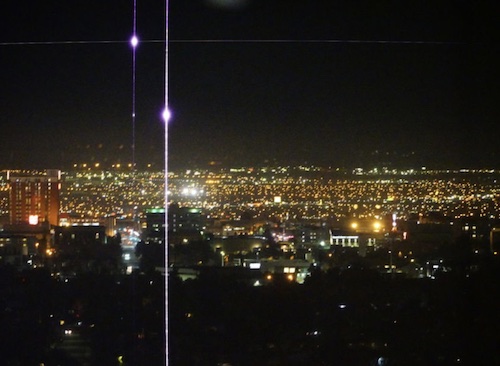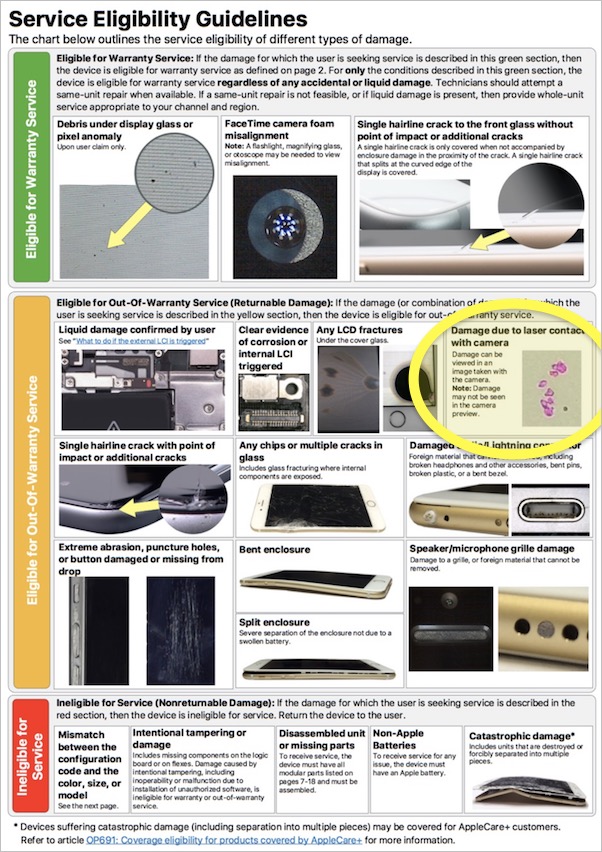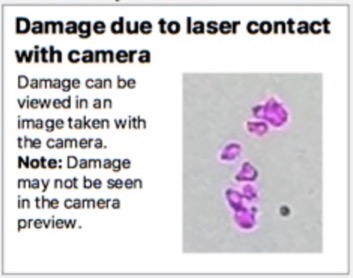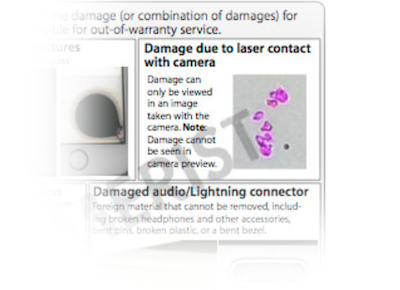Home
A comprehensive resource for safe and responsible laser use
US: Video shows tattoo removal laser damaging $2200 consumer camera
In March 2019, a YouTube video showed laser tattoo removal damaging a high-end digital camera sensor just by taking a video of the laser pulses on the skin.
The laser beam did NOT directly enter the Sony A7SII lens. And yet with every tattoo removal pulse of the green laser, the camera sensor was obviously damaged. According to the person posting the video, "The repair cost was about as much as a new camera [about $2200] so try to avoid this."
If a laser is powerful enough, just looking at the dot of the laser on a wall can be a "diffuse reflectance hazard." In this case, the reflected laser light was powerful enough to damage the sensor.
This is not a flaw in the laser or the camera. As described elsewhere, camera sensors are generally more sensitive than the eye.
Also as noted, different cameras may have different sensitivities depending on many factors. For example, this page includes four YouTube videos showing laser tattoo removal, without any apparent damage to the video sensor.
Laser pointers and handheld lasers are almost always emit continuous wave light. CW lasers can damage the retina by heating it up, while pulsed lasers create an "acoustic shockwave" which instantly causes a popcorn-like explosion in the retina.
According to this page, a typical tattoo removal laser has a maximum pulse energy of about 1-2 Joules and a pulse width of about 5-10 nanoseconds. It is not known how powerful the laser was in the video.
Everyone in the room should have been wearing laser safety glasses or goggles that reduce the laser light to safe levels. If the camera had been shooting through the safety glasses' lens, the damage likely would not have occurred.
From various sources including Reddit, Digital Photography Review, Petapixel, and SlashGear
US: Autonomous car lidar said to damage camera sensor
In early January 2019, a man attending the CES technology show in Las Vegas claimed his Sony A7RII camera's sensor was damaged by the lidar from a company called AEye. Jit Ray Chowdhury said all photos taken after he snapped pictures of the AEye functioning lidar had two purple spots with lines emanating from them:

AEye said that "cameras are up to 1000x more sensitive to lasers than eyeballs. Occasionally, this can cause thermal damage to a camera's focal plane array."
The company offered to replace Chowdhury's camera. Curiously, Chowdhury said he could not find the camera. As laser expert Jeff Hecht wrote, "without the camera it remains unknown what the nature of the damage was, when it occurred, and what caused it."
Companies using lidar for autonomous vehicles choose systems which are safe for human eyes. However, as the AEye incident indicates, some types of lidar may not be safe for camera sensors. These tend to be systems using pulses of laser light, rather than continuous laser light.
From Ars Technica (initial report) and IEEE Spectrum (additional information on lidar characteristics for eye and sensor safety).
UK: "Call for evidence" response summarizes many groups' views on laser eye, plane incidents; sets forth actions
The U.K. government published on January 8 2018 a 14-page report on laser pointer safety and potential regulation. The report includes two new actions the government will take to reduce the number and risk of unsafe laser pointers:
1) “strengthening safeguards to stop high-powered lasers entering the country”, and
2) “working with manufacturers and retailers to [voluntarily] improve labeling.
Separately, the U.K. government published the Laser Misuse (Vehicles) Bill on December 20 2017. This makes it illegal to point a laser at vehicles, with a prison term of up to five years and an unlimited fine.
“Laser pointers: call for evidence - government response”
From August 12 to October 6 2017, the Department for Business, Energy and Industrial Strategy opened a “Call for Evidence” consultation. BEIS set forth 19 questions, asking the public to give their views on laser pointer hazards and what actions to take.
The January 8 2018 government response summarizes the 265 responses received.
The report is especially useful because it incorporates the views of many disparate groups: pilots (64% of respondents), “concerned members of the public” (14%), professional laser safety advisors (9%), users of laser pointers (6%), ophthalmologists (6%), and Trading Standards authorities (2%).
The report then distills these views, finding surprising commonality. It is a good overview for the non-expert on two topics:
1) Actual laser pointer hazards — separating fact from fear
2) Potential actions to reduce the number and severity of laser pointer injuries and incidents — including what actions may not work (e.g., licensing).
We have summarized the findings below (click the “read more” link). However, reading the complete document is well worth the time of anyone interested in this issue.
Click to read more...
US: Apple repair guidelines include laser damage to iPhone cameras
A few pages and graphics were leaked from a 22-page Apple document, the March 3 2017 “Visual/Mechanical Inspection Guide,” including this page showing the service eligibility for common problems:

The page lists common items such as liquid damage, broken screens, cracks — and “Damage due to laser contact with camera.”

It is likely that elsewhere in the leaked document are details about the laser damage, along with other example photos. However, only a few pages of the document were publicly revealed.
A page like this was first revealed in 2014. The document leaked September 1 2017 covers Apple’s most current iPhones: 6, 6S, 7 and associated “Plus” versions.
From Business Insider via MacRumors.
US: Apple repair guide lists laser damage to camera as a service item
This information comes from a 2014 “Visual/Mechanical Inspection” guide provided by Apple to authorized repair centers. An image from the document was provided by a worker to Consumer Reports’ Consumerist blog. In the upper right is the laser damage information:
This item is relatively new. Laser damage is not mentioned in the 2012 version of the iPhone Visual/Mechanical Inspection Guide.
From the Consumerist. For more on laser damage to consumer cameras and camcorders, see our Lasers and camera damage page.
US: Army Research Laboratory works on laser protection for eyes, sensors, etc.
Laser protection team leader Andy Mott was quoted as saying “Lasers of varying pulse width and wavelength are being developed every day. We protect against the known threats, and unknown ones. We develop protection for electronic sensors of the future, as well as the sighting systems of today.”
More details are at the Military.com story
World: Discussion of how lasers damage imaging sensors
This is being posted because some persons may find the ideas presented to be useful. An additional resource is a page at the International Laser Display Association, about damage to cameras at laser light shows.
From Image Sensors World
